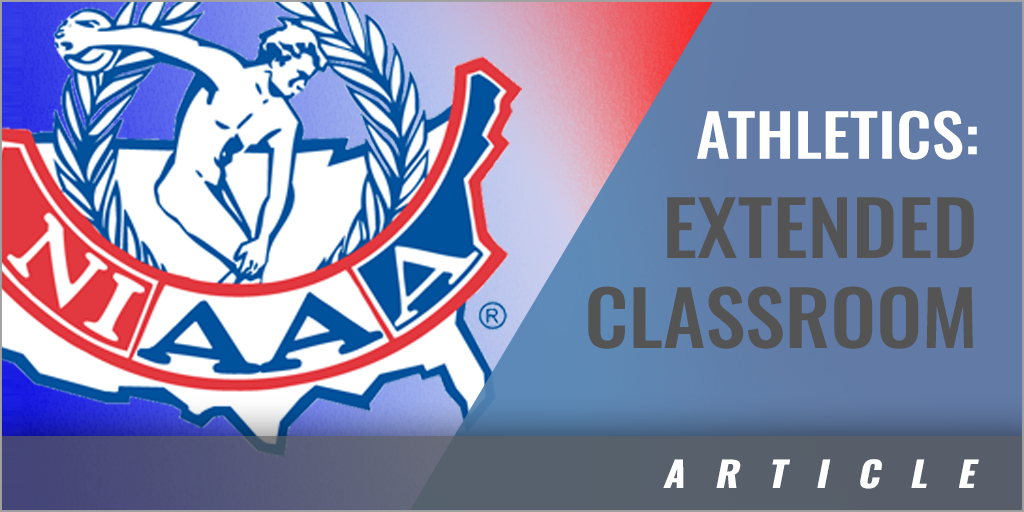|
By: Brittany Spencer Grant, CMAA - Oregon High School (WI) It's probably safe to say that most of us have heard the statement that athletics is an "extension of the classroom." But, what exactly does that mean and how can we have a shared understanding of the benefits afforded to our student-athletes in that extended classroom? Further, how can our student-athletes utilize their experiences in the athletic arena to improve our school? My road into athletic administration is common in the profession. I was a student-athlete, became a coach, went into teaching, and now have transitioned into athletic administration. My former school district has a saying that is promoted regularly, to "Be The Best Knight You Can Be!" During my time as a Knight and now as a Panther, that's really all we want for our students. Our district mission is "helping students acquire the skills, knowledge and attitudes needed to achieve their individual potential." Put simply, to be their best. We value all their experiences that help them to do just that. In addition, we have a wide array of athletic coaches ready to utilize their extended classroom to train, prepare and instruct. According to dictionary.com, a coach is "a person who trains an athlete or a team of athletes." Within other definitions of the word are the terms prepare and instruct. Training, preparing and instructing are all things our teachers do in the classroom, our administrators do through the office, and our coaches do at their athletic venues. In all honesty, they're also things I do at home with my own children, as I'm sure many other parents do as well. In education, we're always searching for opportunities to teach, even when others may not be aware. We search for opportunities to learn and grow too. We both give and receive feedback regularly. In the classroom, our feedback to students is sometimes in the form of a verbal exchange; whereas, other times it may be written in red pen or typed in the comments section. Sometimes it's an email response and a conversation in the hallway. Educators are constantly using multiple methods to provide feedback to students whether that be reinforcing the positive, or constructively correcting an issue. The same variety of feedback is utilized in the athletic arena, where student-athletes are often given instant feedback in response to their actions. Sometimes, it's a visual reward like the ball going in the basket, or the puck crossing the goal line, and points going up on the scoreboard. Other times it's positive actions such as cheers, high fives, and back pats after big plays. However, there are also times when the feedback may be negative such as verbal crowd displeasure, a whistle signifying an infraction, or head shaking from a teammate. Students, and coaches, use all the feedback they receive to reflect on their performance. They do this as they may want to either repeat the action/plan, or avoid it altogether. The positive feedback responses feel good as dopamine is released in the brain, causing the individual to want to repeat the behavior in order to receive that reinforcement again. There is not an equivalent chemical reaction to the negative feedback; however, we all carry memories with us, some of which are stronger than others. Our students, both inside the classroom and outside its walls, are learning how to process through the feedback they receive, so they can be better prepared to respond the next time. Sometimes the next time is moments away; whereas, other times there may be periods or even days before they may face the same situation again. Hopefully, we are all equipping them with the tools and resources they need to respond effectively. But, what are those tools and resources? The physical ones are likely listed on a website, or on a bulletin board at school for easy access. There are also many systems in place during the school day to support our students' diverse needs as individual learners. However, for some of our students, the addition of the extended classroom which athletics provide is just what they need to recharge and prepare for the next day. It is a combination of all these supports that allow each of our students to be their best. And the life skills sports help these students develop are worthy to take notice of, so a number of these skills are included in the graphic below. Source: www.ringor.com How Sports Can Help Your Child Develop Life Skills TIME MANAGEMENT: When your child joins a sport, there are certain responsibilities they must take on. This includes expectations such as getting to practice on time or attending every game. RESPECTING OTHERS: Sportsmanship with their peers as well as opposing players will teach your child to be mindful and respectful of those around them. When you play a sport, you're also expected to listen to the coaches and do what they ask. LEADERSHIP: Sports are an excellent environment to learn leadership skills. Maintaining a positive attitude and keeping others motivated is something that kids can use in many other situations outside of sports. TEAMWORK: Learning how to put aside differences and come together to achieve a shared goal is not just something kids need when playing sports. They can use this approach at school and work in the future. COMMUNICATING WITH OTHERS: In sports, communication is something many don't think about, but it is an important part of any game. No matter the sport, it gives young kids the opportunity to socialize with others and converse, which can be a hard thing to come by in today's digital age. WORKING UNDER PRESSURE: It's typical to feel pressure during a game. From coaches yelling to time running out, figuring out how to work under these conditions can help your child a lot in the long run. It's an opportunity for them to learn how to control their emotions and focus on the task at hand. HANDLING CRITICISM: To understand constructive criticism and use it as fuel for motivation is a good tactic to master at an early age. If a coach yells at your child, don't take it to heart - it is just them showing that they care about your child performing well. HARD WORK: While sports can be fun, it can also be difficult as you improve your skill and advance levels. Being able to learn perseverance and not give up on what you want as it gets more demanding can play into how your child will approach life. COMMITMENT: Committing to something and sticking with it is another powerful ability that will help your child succeed in life. There will always be a point when things get difficult; however, being able to stick with it instead of quitting is an extremely valuable characteristic to have. COMPETITION: The great thing about sports is that it can teach your child how to be competitive in a safe setting. Contending with the person next to you and pushing yourself to do your best is helpful in many real-life situations. SELF-ASSURANCE: Knowing what it feels like to fail and succeed can instill confidence in your child and provide them with a strong sense of character. Things aren't always going to go our way and knowing how to cope with that is essential. HEALTHY LIFESTYLE: Living a healthy life is something that can be incredibly beneficial for your child once they become an adult. By playing sports at a young age and having an active lifestyle early on, it sets the stage for health habits in the future. With these 12 skills in the back of my mind, I asked some of our student-athletes what life skills or lessons they've learned through athletic participation in our extended classroom, and the top 5 common responses were:
As these student reflections show, our students really do learn multiple life skills and lessons through athletic participation in our extended classroom! Furthermore, my interactions with students have showcased how these skills they learn in athletics benefit them both in and outside of the classroom in numerous ways. Clearly, our coaches continue to teach more than just the X's and O's after school. Moving forward, imagine what we can do when we all get intentional with the tools and resources we equip these student-athletes with in the extended classroom that athletics provide. |







